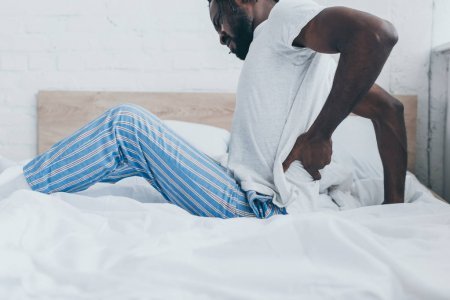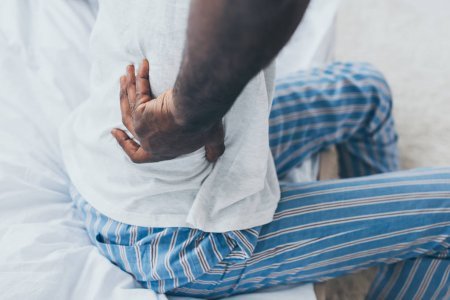Persistent pain is not an inevitable part of aging but is fairly common among the elderly. The treatment of pain may be complicated by multiple problems that are far less likely to occur in younger adults. Bones and discs in our spines can degenerate over time, causing stiffness and soreness. But back pain doesn’t need to be an inevitable part of aging if you take the right lifestyle approach.
Nearly all of us experience back pain sometime in our lives, and the list of possible back pain causes is long — poor posture, being overweight, smoking, poor eating habits, spinal diseases, and other health conditions, including cancer. And then there’s the number-one back pain cause: aging. Just using our backs over time can cause back pain, it is just normal wear and tear.
What is causing the ache? The reason is not far-fetched; the trend is largely due to occupational exposure among working-age adults, for example, our fast civilizing world offers many conveniences, particularly in the area of technology and it has made life much easier than in the former times. Our standard of living engenders a high price that is paid by many people in form of pain. One of the most important areas affected by this pain is the human back. Take for instance, this computer age, many people spend hours on their computers subjecting their backs to undue physical stress. The way the back was created was not to be in sedentary position always. A little knowledge of biology will help us to appreciate this. Your spine consists of individual bones called vertebrae, which are stacked one on top of the other. Between each vertebra are small joints that allow your spine to move and discs with jelly-like centres that act as shock absorbers and prevent your bones from rubbing against each other.
As we age, the discs between the vertebrae wear away and shrink, which causes pain and stiffness as the bones start to rub against each other. In addition, the space around our spinal cord narrows over time. This condition, known as spinal stenosis, also puts pressure on the cord and spinal nerves, causing pain.
To keep your back from hurting as you age, it’s very important to have good posture when you stand or sit, maintain a healthy weight, eat a good diet with needed nutrients for joint and bone health, exercise to keep your back and abdomen strong and flexible, and reduce stress. Indeed people with healthy habits can age better.
If you do experience back pain, even if you think the cause is aging, don’t ignore it. It could be a sign of a serious, but treatable disease. You don’t have to live with back pain, no matter what your age. Talk to your doctor for referral to a reputable physiotherapist and experience indelible impact on your back pain challenge. Indeed rehabilitative aspect of pain management (physiotherapy) can help the patient live a more independent and functional life.
It is on record that the elderly population comprises the fastest growing segment of the world’s population. As patients age, the incidence and prevalence of
certain pain syndromes such as back pain increase. Back Pain may be under reported as some elderly patients incorrectly believe that pain in the back is a normal process of aging.
Pain in the absence of disease is not a normal part of aging, yet it is experienced daily by a majority of older adults, globally. Older adults are at high risk for under- treatment of their back pain due to a variety of barriers. These include lack of adequate education of health care professionals on referral system, cost concerns and other obstacles related to the health care system, and patient related barriers, such as reluctance to report pain in their back. Unrelieved pain in the older adult has significant functional, cognitive, emotional, and societal consequences.

Professionally speaking, most deformities in our elderly people are the visible effects of poor postural habit or persistent back pain that was not properly dealt with earlier or neglected. This would eventually result to secondary and sometimes severe consequences when their effects are transmitted to our body organs. Organs such as the lungs are constricted and breathing is affected. The stomach and other internal organs may be deprived of their correct support.
Invariably this could bring about the interference with bowel movement (toileting), urine control and even penile erection. No doubt, debilitating back pain has affected the effective performance of some vital organs in the body of most victims. Chronic back pain has rendered many people bed-ridden and wheelchair- bound!
Early diagnosis, treatment and referral of victim of common back pain to a reputable physiotherapy clinic, is crucial because severe cases of the condition can lead to serious functional disability and poor treatment outcomes.
Despite the magnitude of the problem most people do not get adequate and cost-effective treatment for their agonizing back pain. They continue to suffer month after month year after year. Why? This is because many of the victims of the common back pain are irrational in the choice of health facility to attend and get effective and dramatic relief for their disturbing pain in the back and their affected hand or leg.
They have paid the price of their negligence and ignorance in years of pain and uncountable numbers of medical appointments with some health practitioners feigning ignorance of the existence of a referral system involving specialist health facilities such as a functional and reputable physiotherapy outfit, for such stubborn health condition.
We are not getting younger. We are ageing. The effects of ageing can result in bones being brittle, muscles and ligaments decreasing in strength and elasticity. However, the effects can be slowed by a labour-intensive care of a skilled physiotherapist, who would use not only the available modalities to bring back function, but also restore muscle strength, teach and educate the victim on some therapeutic exercise regimen that will improve his reflexes and align his body.
It is now known that acute back pain tends to occur less frequently in each person once we pass the age of 55years. So if you are over 55 years, (or little younger) you may have noticed that you experience a more persistent ache in the back especially in the waist than you previously had, but that you no longer have the acute and severe episode that affected you when you were younger. This arching can cause significant problems, especially if you are forced to reduce activity.
The human body thrives on activity and decays with prolonged inactivity. It is undesirable for any of us, regardless of age, to reduce our level of activity, only if reduced activity is forced on us by significant health-related problems, should we exercise less.
Don’t accept back pain as you would accept gray hair on the head! Talk to your doctor for referral to a skilled physiotherapist. Please still stay safe and remain fit!.
Dr. Charles Chidi Ehirim (08033299222\ 08187524972)
Consultant Physiotherapist
OMEGA PHYSIOTHERAPY & BACK PAIN CARE CLINICS

![]()






